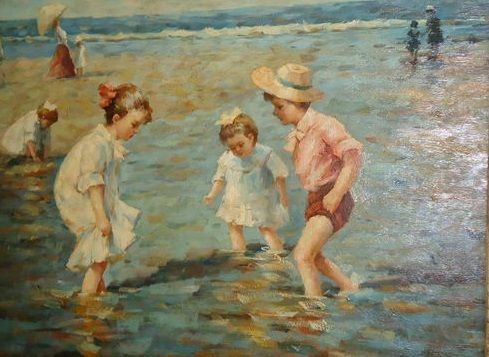
The History and Future of Childhood: Representing Children in Late Third Republic France (1900–1940)

This is part of our Campus Spotlight on Princeton University.
In 1922, the Franco-Belgian journalist Clément Vautel published a dystopian story entitled Le dernier gosse (“The Last Kid”). Printed in the satirical journal Le Rire, it foretells of a 1950s France where there are no new births, save one—a miraculous “last child.” Living in a world without young people, the protagonist is consigned to a miserable existence. Rare and bizarre, he is requisitioned by the state and spends his brief life, cut short by a lack of pediatric care, behind cold museum glass, observed by biologists and ogled by a sterile public unfamiliar with the sights and sounds of youth. After the boy passes away, so too does France. With the country’s only hope for children extinguished, neighboring states waste no time invading French borders, making swift work of defeating its wizened army of septuagenarians.[1]
Vautel’s tale, which recalls P.D. James’s chilling novel The Children of Men, speaks to the anguish that many in France’s Third Republic (1870–1940) felt regarding the nation’s demographic “health.”[2] Since the mid-nineteenth century, population statistics had called attention to the fact that French birthrates lagged behind those of Germany, Great Britain, Russia, and the United States. These demographic woes, already causing alarm in the Belle Epoque, would grow more acute during and after World War I, as fathers and would-be fathers perished on the battlefield.[3] Part parody and part polemic, “The Last Kid” asked readers of Le Rire to imagine what might happen if France did not take swift action to remedy its baby problem. What would the future for France be like in the absence of French children? How long would the country survive?
As Le dernier gosse demonstrates, the child is arguably the quintessential emblem of futurity. Indeed, as art historian Anne Higonnet has argued, childhood is “essentially the subject of how we form and value our collective future.”[4] My dissertation, jointly in Princeton’s Department of History and Interdisciplinary Doctoral Program in the Humanities, departs from this observation. In my project, I consider how children and childhood were depicted during the second half of the Third Republic (c. 1900–1940), a time when the future of France and its children were fascinatingly elided. If, in Roxanne Panchasi’s phrasing, “the future anticipated at a particular historical moment can tell us a great deal about… the present doing the anticipating,” my dissertation contends that there is much to be learned from the ways French citizens portrayed children and childhood in the decades preceding and following World War I.[5]
Scholars have convincingly demonstrated there were few times in French history more oriented toward “reproductive futurism”—a politics centered on promoting heterosexual reproduction and acting in the interest of children—than late Third Republic France.[6] It was during this period that the pronatalist movement reached its height of popularity, with the desire to expand the French population becoming one of the only causes to garner near universal support across social and political factions.[7] Previous scholarship has made clear how French society was reorganized, legally and socially, for the benefit of the child and, to a lesser degree, for the women charged with birthing and raising them.[8] Less studied are the specific attributes of the imagined child in whose name natalists acted and claimed rights. For which child, and for which type of childhood, was a French future envisioned? As a member of IHUM, I am fortunate to be able to take a multifaceted approach to answering this question, attempting to reread the history of Third Republic pronatalism through the lens of art history, museum studies, and media theory, among other fields.
My research is still in its early stages, but I would like to share one of my most exciting insights to date. In the first section of my project, I examine the broad cultural initiatives of natalist and child welfare activists, with a particular focus on childhood exhibitions mounted between 1900 and 1940. In researching these exhibitions, I have begun to notice a curious trend, namely, that many of the men and women most invested in French children’s future possessed an ironic impulse to historicize them as a part of the French past. That is, in order to ensure the longevity of children, it seems that it was necessary to reconfigure symbols of futurity as figures of history. To give an example, in 1901 a group of child philanthropists organized L’Enfant à travers les âges (“The Child Throughout the Ages”), a large-scale exhibition at Paris’s Petit-Palais to raise funds for poor youth and raise awareness about child proper childcare and hygiene. Rather than merely showcase the plight of needy children, or instruct parents in puericulture (the science of child-rearing), the organizers opted to give a significant part of the venue over to ornate presentations on the history of French childhood. Walking through the exhibition, visitors were enchanted by galleries filled with old toys, games, and cribs, and moved by displays of prerevolutionary artwork depicting boys and girls of generations past. At the exhibition’s close, spectators were treated to a final delight: a room filled with images of celebrities as children that let the public see a new side of their favorite actresses and politicians.[9] Bolstering the future of French children by alluding to their storied history, analysis of “The Child Throughout the Ages” and other exhibitions of its kind suggests that, in addition to inaugurating a new political and legal regime of childhood, demographic crisis pushed forward a new historical paradigm for childhood. It took, in other words, confronting a future without children to begin to root the child in the past as a figure defined not just by chronological but also historical time.
The history of childhood is typically associated with the mid-twentieth century, in particular, the publication of Centuries of Childhood (1960), a groundbreaking work by Philippe Ariès that analyzed the social and cultural construction of “childhood” in the West. Brought up during the Third Republic, Ariès remains a father figure of the history of childhood, despite the fact that many of the claims in Centuries of Childhood have since been disputed.[10] Without denying the importance of this work or of its time of publication, I uncover older roots for the history of childhood in the Third Republic. Acknowledging that Ariès’s scholarship could not have been achieved without a specific set of developments within the historical discipline, my research points to a broader tradition of imagining the child as a historical figure within French popular culture. It also points to the entanglement of the natalist movement and the history of childhood as a field, allowing us to gain new insights into the precise “Euro-American context that gave rise to the ‘history of children and childhood,’” and thus, the Euro-American origins of the standards we use to measure who gets to count or be treated as a child.”[11]
Furthermore, as later sections of the dissertation address, such exhibitions help us to unravel the history of contemporary associations between good parenting and documentary practices. In her 2010 study, anthropologist Gillian Rose demonstrates that many twenty-first-century mothers view taking and storing family pictures as an essential component of their maternity.[12] Some of the origins of this idea are, my research indicates, to be found in the fin-de-siècle. Early galleries of “The Child Throughout the Ages” worked to establish the child as a historical subject. The display of celebrities-as-children added a complex layer to this message. Expanding the purview of celebrity imagery, the visual trope of the celebrity-as-child implicitly urged parents to record and archive their own children. In reminding the public that that the men and women who made French history were once mere boys and girls, the gallery posited that children were not just a part of French history but also its authors. As Jeanne Brémontier noted in her review of the show for Le Matin, the exhibition was certain to be a great hit with photographers and painters, who were bound to receive thousands of new commissions for child portraiture in the exhibition’s wake: “From now on all parents will want to have a portrait of their children in the case that they become famous.”[13]
The urge to document the child persists and has, arguably, become stronger and more pervasive with the advent of social media. In addition to shedding new light on French history, it is my hope that my project will help us ask new questions about contemporary representational practices. North America and Europe teeter on the edge of another proverbial “demographic cliff.”[14] In contemporary European and North American societies, how do we represent our children? And in the service of what futures?
Hannah Stamler is a PhD candidate in History and Interdisciplinary Humanities at Princeton University. She is also a practicing art critic, whose writing has appeared in Art in America, Artforum, and The Nation, among other outlets.
References
[1] Clément Vautel, “Le dernier gosse,” Le Rire, May 27, 1922, 4–5. Vautel, a militant natalist and anti-feminist, is discussed in Mary Lou Robert’s excellent work on gender in interwar France: Mary Louise Roberts, Civilization Without Sexes: Reconstructing Gender in Postwar France, 1917-1927(Chicago: University of Chicago Press, 1994).
[2] In her acclaimed book, James describes Great Britain of the 2020s plagued by mass infertility. See P.D. James, The Children of Men, 1st U.S. edition (New York: Knopf, 1992).
[3] For a good overview on the rise of demography and population studies in the nineteenth century, see Joshua Cole, The Power of Large Numbers: Population, Politics, and Gender in Nineteenth-Century France (Ithaca: Cornell University Press, 2000).
[4] Anne Higonnet, Pictures of Innocence: The History and Crisis of Ideal Childhood (London: Thames and Hudson, 1998), 14.
[5] Roxanne Panchasi, Future Tense: The Culture of Anticipation in France Between the Wars (Ithaca, NY: Cornell University Press, 2009), 4.
[6] I borrow this term from Lee Edelman: Lee Edelman, “The Future Is Kid Stuff,” in No Future, Queer Theory and the Death Drive (Durham, NC: Duke University Press, 2004), 1–32.
[7] On the rise the pronatalist movement after World War One, see Françoise Thébaud, “Le mouvement nataliste dans la France de l’entre-deux-guerres : l’Alliance nationale pour l’accroissement de la population française,” Revue d’Histoire Moderne & Contemporaine 32, no. 2 (1985): 276–301, https://doi.org/10.3406/rhmc.1985.1318.
[8] It is impossible to cite all the works on this topic, but for example, see the classic texts: Rachel G. Fuchs, Mary Lynn Stewart, and Elinor Ann Accampo, eds., Gender and the Politics of Social Reform in France, 1870-1914 (Baltimore: Johns Hopkins University Press, 1995); Anne Cova, Maternité et droits des femmes en France : XIXe-XXe siècles (Paris: Anthropos, 1997); Rachel G. Fuchs, Abandoned Children: Foundlings and Child Welfare in Nineteenth-Century France (Albany: State University of New York Press, 1984); Karen Offen, “Depopulation, Nationalism, and Feminism in Fin-de-Siècle France,” The American Historical Review 89, no. 3 (1984): 648–76, https://doi.org/10.2307/1856120; Jean Elisabeth Pedersen, Legislating the French Family: Feminism, Theater, and Republican Politics, 1870-1920 (New Brunswick, NJ: Rutgers University Press, 2003).
[9] On the various tropes of celebrity invented in the nineteenth century, see Sharon Marcus, The Drama of Celebrity (Princeton: Princeton University Press, 2019).
[10] The French edition was published in 1960, followed by an English translation in 1962. For the first English translation, see Philippe Ariès, Centuries of Childhood: A Social History of Family Life, trans. Robert Baldick (New York: Vintage Books, 1962). On Ariès as a father figure to the history of childhood and the ongoing debates over his work, see Patrick H. Hutton, “Decades of Debate about Centuries of Childhood,” in Philippe Aries and the Politics of French Cultural History (Amherst: University of Massachusetts Press, 2004), 92–112.
[11] Ishita Pande, “Is the History of Childhood Ready for the World? A Response to ‘The Kids Aren’t All Right,’” The American Historical Review125, no. 4 (2020): 1300–1305, https://doi.org/10.1093/ahr/rhaa383.
[12] Gillian Rose, Doing Family Photography: The Domestic, The Public and The Politics of Sentiment (Farnham, UK: Ashgate, 2010).
[13] Jeanne Brémontier, “L’Exposition de l’enfance,” Le Matin, March 12, 1901, 1.
[14] See, for instance, “The Demographic Cliff: 5 Findings From New Projections of High-School Graduates,” The Chronicle of Higher Education, December 15, 2020, https://www.chronicle.com/article/the-demographic-cliff-5-findings-from-new-projections-of-high-school-graduates.
Photo: French School in the late 19th / early 20th century, Oil on panel, J.Claude




